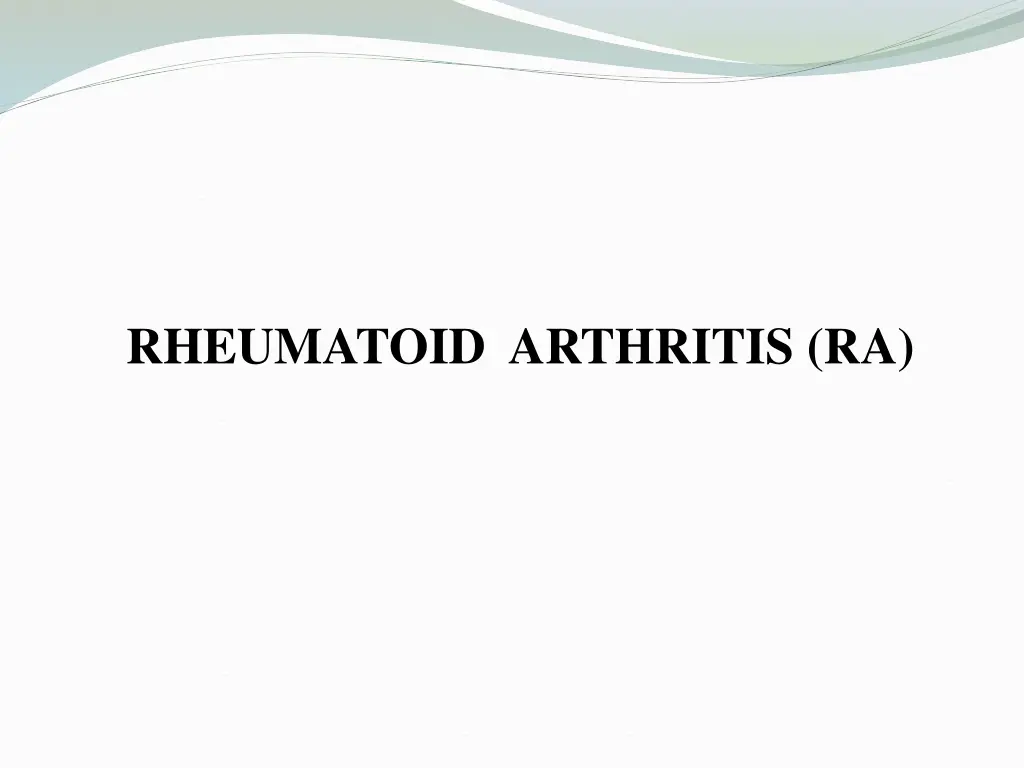
Understanding Rheumatoid Arthritis: Symptoms, Causes, and Management
Rheumatoid Arthritis (RA) is a chronic inflammatory disorder affecting joints, leading to joint destruction and deformity. Learn about its symptoms, causes, laboratory tests, and treatment options for better management of the condition.
Uploaded on | 9 Views
Download Presentation

Please find below an Image/Link to download the presentation.
The content on the website is provided AS IS for your information and personal use only. It may not be sold, licensed, or shared on other websites without obtaining consent from the author. If you encounter any issues during the download, it is possible that the publisher has removed the file from their server.
You are allowed to download the files provided on this website for personal or commercial use, subject to the condition that they are used lawfully. All files are the property of their respective owners.
The content on the website is provided AS IS for your information and personal use only. It may not be sold, licensed, or shared on other websites without obtaining consent from the author.
E N D
Presentation Transcript
RA is a chronic, systemic inflammatory disorder of unknown etiology characterized by the manner in which it involved joints Progressive variable degrees of incapacitation joint destruction and deformity leads to F:M=2-3:1 40-60 years old
Etiology Genetic factors: HLA-DR4 Infection
Etiology Rheumatoid factors (RF) are antibodies with specificity for antigenic determinates on the Fc portion of human or animal IgG. Currently, the most popular notion that RF arise as antibodies to altered autologous IgG
Clinical features The onset of RA is frequently heralded by prodromal symptoms such as fatigue, anorexia, weight loss, weakness and generalized aching and stiffness Joint disease Extraarticular manifestations
Xerostomia (Dry Mouth) Xerophthalmia (Dry Eyes)
Rheumatoid Vasculitis Rheumatoid Vasculitis RA Deformities
Laboratory findings Anemia of moderate degree ESR a useful parameter for assessing response to therapy C-reactive protein RF (usually IgM) CIC , complements ANA Anti-CCP (cyclic citrullinated peptide)
Rheumatoid Factor Antibodies to Fc portion of IgG 75-80% of Patients have during course of disease Useful for prognosis
Rheumatoid Factor IgG Molecule Fc Portion Autoantibodies Autoantibodies (IgM) directed (IgM) directed against the Fc against the Fc Fragment of IgG Fragment of IgG An Antibody to an An Antibody to an Antibody Antibody Antigen Binding Antigen Binding Groove Groove Their Role in RA is Their Role in RA is not understood not understood
Rheumatoid Factor RFs are human auto-Abs that react with the Fc portion of normal polyclonal IgG. Most routine clinical assays for RF detect only IgM RFs, although RFs can be any class of immunoglobulin Named thus because their first description was in patients with rheumatoid arthritis
Rheumatoid Factor RF test is approximately 65%-75% sensitive for the diagnosis The presence of RF, even in high titers or large amounts, is not specific for RA
Condition Associated With (+) Tests for RF Rheumatologic Diseases Rheumatologic Diseases Rheumatoid arthritis (~70%) Sj gren s syndrome (~90%) Lupus (~20%) Cryoglobulinemia syndrome (90%) Lung Diseases Lung Diseases Interstitial fibrosis Silicosis Infections Infections Hepatitis C virus Acute viral infections Endocarditis Tuberculosis Miscellaneous Miscellaneous Sarcoidosis Malignancies Aging
Methods for detection FR Agglutination (latex) ELISA RIA Torbidometry Nephlometry
Agglutination Definition: the clumping together of antigen bearing cells, microorganisms or particles in the presence of specific antibodies Particles may be RBCs (hemagglutination), bacterial cells (coagglutination) or inert particles such as latex or charcoal coated with antigen or antibody
Agglutination Reactions Advantages: Easy to carry out No complicated equipment needed Can be performed as needed Available in pre-package kits with controls Reactions are QUALITATIVE, i.e., positive or negative Titers can be performed to give semi-quantitative results
Agglutination (The Antigen is a Partiulate) Qualitative: Slide Agglutination Tasts Semi Quantitative: Tube Agglutination Tests Qualitative: Primary Reaction (ELISA, )
Slide Test Agglutination -- Qualitative Method Latex agglutination
Tube Test Agglutination -- Semi Quantitative Method Tube Agglutination Tests: Identify & Titrate antibodies in the patient sserum. Titre: is defined as the reciprocal of the highest dilution of serum showing agglutination. 1/200 1/400 1/100
Passive Agglutination Converting a precipitating test to an agglutinating test Chemically link soluble antigen to inert particles such as LATEX or RBC Addition of specific antibody will cause the particles to agglutinate Reverse PAT: antibody linked to LATEX e.g. Lancefield grouping in Streptococci.
Passive Agglutination - Rheumatoied Rheumatoied Factor ( Factor (IgM IgM) ) Latex Latex Human Human IgG IgG ( (Intact Intact Ab Ab) )
Reverse Passive Agglutination - CRP CRP Latex Latex Latex Latex Anti CRP Anti CRP- -Ab Ab Anti CRP Anti CRP- -Ab Ab
ELISA ELISA Quantitative Method
